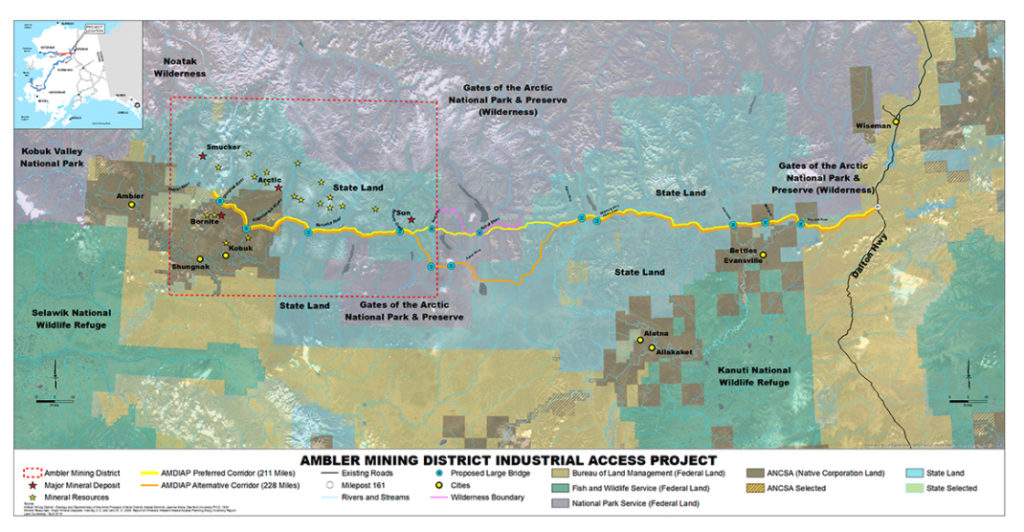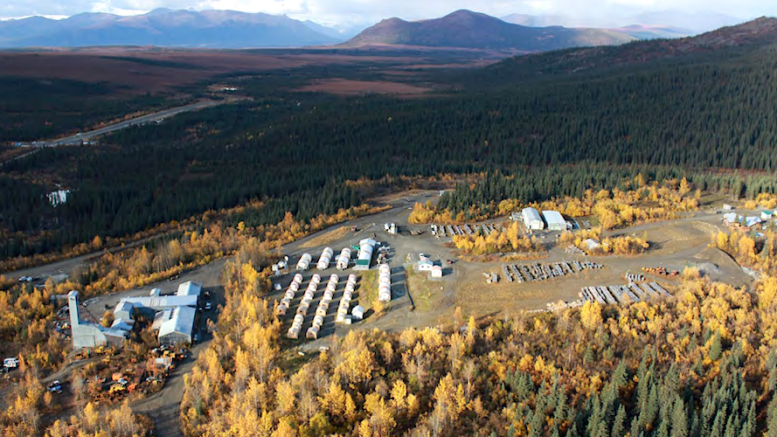The proposed 211-mile transportation corridor for accessing untouched mineral deposits in northwestern Alaska, also known as the Ambler road project, will likely cause harm to wildlife and disruptions to local communities, according to the latest environmental review by the Biden administration.
In a draft supplemental environmental impact statement (SEIS) released on Friday, the U.S. Department of the Interior found that as many as 66 communities whose subsistence-style living activities could be affected. Nearly half of those could face significant impacts because of the road, the agency added.
“Subsistence use would be altered by the presence of a road, both because a road would affect wildlife behavior and because it would bisect travel routes used by hunters and affect their access to subsistence use areas,” the report stated.
According to a 2018 feasibility study, the Upper Kobuk mineral projects (UKMP) in the Ambler mining district could produce 159 million lb. of copper annually over a 12-year life span, as well as 199 million lb. of zinc, 33 million lb. of lead, 3.3 million oz. of silver and 30,600 oz. of gold. The project, consisting of the Arctic and Bornite assets, is owned by Ambler Metals, a joint venture of Trilogy Metals (TSX: TMQ; NYSE: TMQ) and South32 (LSE: S32; ASX: S32; JSE: S32).
The Ambler access road was previously granted a permit by the Trump administration in July 2020 despite objections by local groups. However, in 2022, the Biden administration reeled back on the decision under the premise that its environmental impact had not been adequately studied.
The DOI review, which examined the impacts from three potential routes for the proposed road, also updated the potential effects of the road on caribou and fish. Specifically, it found that all the options for a road would fragment wildlife habitat, altering the movement and migration of caribou and other animals, partly because of vehicle noise, though some proposals would have more impact than others.
With caribou already under pressure from other development and climate change, the road could affect calving and survival rates, the analysis added.
Steve Cohn, the agency’s Alaska state director, said the review includes more robust input from talks with Alaska Native groups. “Continued public input and engagement on this draft is critical to ensuring our analysis captures the proposed road’s potential impacts,” Cohn said in a statement.
While not final, these findings offer further setback to a project that mining companies and renewable energy proponents consider to be crucial not only to the U.S. economic growth but also its climate strategy.
“Given the clear terms of the law and the strategic importance of this project, you would expect the Biden administration to prioritize its approval with reasonable mitigation measures for subsistence. Instead, perhaps with an eye toward Halloween, this analysis looks to be filled with environmental boogeymen,” Republican Senator Lisa Murkowski said in a statement.
Fellow Republican Dan Sullivan also shared his frustration, stating that energy and critical minerals are one of America’s greatest strengths. “Remarkably, the Biden administration has sought to unilaterally disarm these strengths, including with today’s Ambler Road supplemental EIS, which sets up more hurdles to access one the biggest deposits of much-needed critical minerals in our country.”

“The Ambler Access Project was authorized in federal law over 40 years ago and has support across Alaska and within the region,” Ramzi Fawaz, chief executive of Ambler Metals, stated. The company is “confident” it can address any issues raised in the new analysis, he added.
The Alaska National Interest Lands Conservation Act (ANILCA) of 1980 guarantees a right-of-way (ROW) across federal lands to provide access to the Ambler mining district. The Bureau of Land Management and National Park Service initially granted a 50-year ROW for the access road, but the permit was suspended by the DOI’s request to conduct the SEIS.
The draft SEIS now enters a 60-day public comment period. The administration will then issue a final environmental impact statement, followed by a final decision, expected sometime next year.


Be the first to comment on "US DOI draft study poses further setback for Alaska’s Ambler road project"